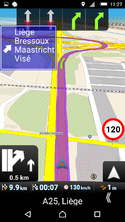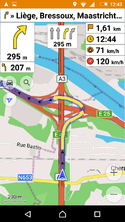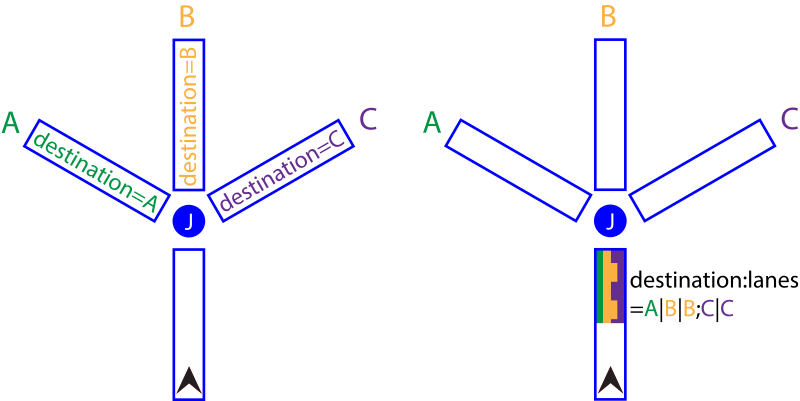ES:Key:destination
 |
| Descripción |
|---|
| La clave destination describe el contenido de las señales verticales u horizontales que indican los nombres de los lugares a los que se dirige la vía etiquetada. |
| Grupo: propiedades |
| Usado en estos elementos |
| Combinaciones útiles |
| Estado: de facto |
| Herramientas para esta etiqueta |
La clave destination=* nombra los objetos que se alcanzan, cuando se sigue una característica lineal. La clave se utiliza tanto en el sistema de carreteras como en las vías fluviales.
Destino de carreteras
En el sistema de carreteras, la clave destination=* describe el contenido de las señales o la escritura en el suelo que indica los nombres de las ubicaciones a las que se dirige la vía etiquetada. Por lo tanto, los sistemas de navegación pueden referirse a las señales de tráfico que el conductor realmente ve.
Claves
| Variación clave | Válido para | Descripción |
|---|---|---|
destination
|
Vía | Describe el destino de la vía OSM completa. Es útil solo si se usa en combinación con oneway=yes.
|
destination:forward
|
Dirección | Describe el destino de todos los carriles de la vía OSM, que van en la misma dirección que la misma vía. |
destination:backward
|
Dirección | Describe el destino de todos los carriles de la vía OSM, que van en la dirección opuesta que la misma vía. |
destination:lanes
|
Carril | Describe el destino de cada carril de la vía OSM. Es útil solo si se usa en combinación con oneway=yes.
|
destination:lanes:forward
|
Carril | Describe el destino de cada carril de la vía OSM, que van en la misma dirección que la misma vía. |
destination:lanes:backward
|
Carril | Describe el destino de cada carril de la vía OSM, que van en la dirección opuesta que la misma vía. |
Ten en cuenta que destination=* y destination:lanes=* son dos conceptos diferentes para respaldar el anuncio de destinos señalizados, que pueden ser evaluados de manera diferente por el software de navegación. Como no entran en conflicto, ambos enfoques pueden coexistir en una vía en particular. Consulta la figura siguiente para obtener una ilustración.
Destinos por vía
Si la carretera es oneway=yes, entonces:
- Utiliza la clave
destination=*.
Si la carretera es bidireccional, entonces:
- Utiliza
destination:forward=*para describir los carriles en la dirección del sentido de digitalización. - Utiliza
destination:backward=*para describir los carriles en la dirección opuesto al sentido de digitalización de la vía.
Para que el software de navegación pueda anunciar el destino en una intersección, la carretera que sale de la intersección debe llevar la respectiva clave destination=* según lo indicado en las señales. Se pueden etiquetar múltiples destinos como valores separados por punto y coma.
Al menos el primer tramo de una carretera que sale de la intersección debe estar etiquetado; sin embargo, el etiquetado puede continuar en segmentos posteriores hasta que se señale un destino diferente. Este método permite que el software de navegación muestre continuamente qué destino sigue un conductor, por ejemplo, a lo largo de una carretera de doble calzada.
Forward y Backward
Nota importante: Si una carretera de entrada y una de salida comparten una vía OSM, porque no están construidas por separado, etiqueta los destinos con destination:forward=* y destination:backward=*. Si inviertes la dirección de la vía OSM, ¡asegúrate también de intercambiar esas etiquetas de destino! El editor JOSM muestra un mensaje de advertencia y sugiere intercambiar destination:forward=* con destination:backward=*. El editor iD intercambia las etiquetas automáticamente al invertir la dirección de la vía.
Destinos por carril
Para obtener detalles sobre el sufijo :lanes, consulta
- Artículo principal: Lanes.
A menudo, los destinos de una carretera varían de carril a carril, típicamente en conjunto con turn:lanes. Para especificar esos destinos para cada carril, se usa destination:lanes=* en el segmento de carretera que conduce a la intersección. Para etiquetarlos:
Si la carretera es oneway=yes entonces:
- Usa la clave
destination:lanes=*. - Visualiza la carretera en la dirección de la vía en OSM.
- Añade los valores de los carriles al valor, comenzando con el carril más a la izquierda y terminando con el carril más a la derecha. Separa cada valor de carril con una | (barra vertical).
- Si la carretera es bidireccional, entonces:
- Usa
destination:lanes:forward=*para describir los carriles en la dirección de la vía en OSM. Visualiza la carretera en la dirección de la vía en OSM. - Usa
destination:lanes:backward=*para describir los carriles en la dirección opuesta a la vía en OSM. Visualiza la carretera en la dirección opuesta a la vía en OSM.

¿Dónde utilizar?
Usa destination=* junto a highway=* en la parte de la vía de después de la señal o pintada en el suelo. Para detalles, ver los ejemplos.
¿Debería usar claves destination=* o una relación destination_sign?
La implementación de destination=* funciona cuando todas las vías de entrada a un punto de intersección están señalizadas con los mismos destinos de salida para la misma vía de salida. Esto hace que destination=* sea una elección popular entre los editores para: autopistas y otras vías de un solo sentido; en relaciones de vías fluviales (las vías fluviales son por definición de un solo sentido, en su dirección de flujo); y para intersecciones simples.
En las intersecciones donde el destination=* indicado depende de la dirección desde la que llega el conductor (esto puede ocurrir en intersecciones de doble sentido o rotondas), esta implementación no puede proporcionar suficiente detalle para ser inequívoca para la navegación, ya que múltiples destinos aplican para la misma vía de salida. En estos casos, se debe usar la relación destination_sign para proporcionar la granularidad necesaria.
Para indicar la ubicación física de la propia señal, utiliza information=guidepost.
Posibles errores por confusión de uso
No confundir con highway=motorway_junction:
- Solo se utiliza en nodos de salida de autopistas.
- El nombre oficial de una salida se expresa con la clave
name=*. En algunos países, el mismo nombre se aplica por igual a cada salida. Si es así,name=*puede no indicar correctamente un destino preciso.
No confundir con Relation:destination_sign:
- Esta relación está diseñada para cualquier señal que se muestre en cualquier dirección (muy flexible). En principio, sería posible usar la relación para cada señal de destino, pero trae consigo todos los inconvenientes de las relaciones (a diferencia de una etiqueta simple como "destination").
No confundir con designation=*:
- Es la clasificación legal oficial de una carretera o camino y no tiene nada que ver con la información sobre hacia dónde va una vía. Por favor, no confundir con la forma de escritura similar.
No confundir con direction=*.
Software que usa esta etiqueta
Etiquetado destination=*


destination=* se utiliza en las siguientes aplicaciones de navegación:
- Scout [1].
- OsmAnd [2].
- Uso previsto por Skobbler Navigation [3].
- Mapfactor Navigator
- Magic Earth
- mkgmap
- CheckAutopista [4] es una herramienta de control de calidad que puede mostrar las etiquetas
name=*,exit_to=*odestination=*en una autopista seleccionada. Ayuda a detectar datos faltantes.
La API de Mapbox Directions y OSRM admiten las etiquetas destination=* y destination:ref=*. Mapbox Navigation SDK muestra estos valores de etiqueta en la tabla de pasos y el banner de giro y también lee en voz alta los valores de etiqueta.
Etiquetado destination:lanes=*
Si conoces sistemas de navegación que utilizan este estilo de etiquetado, agrégalos aquí.
Valor
El valor de la etiqueta de destino (destination) debe ser el contenido de la señal, tal como se leería de principio a fin. Los diferentes destinos en la misma señal se separan con punto y coma. (Ver ejemplos a continuación).
Esta clave es solo para valores que están explícitamente indicados en las señales o en inscripciones en el suelo.
El uso de abreviaturas (tal como aparecen exactamente en una señal) en una etiqueta de destino está siendo discutido y es controvertido, en la página de discusión de esta etiqueta. Numéricamente hablando, en una proporción de 20:1 el consenso de edición sobre si se deben usar abreviaturas que aparecen en las señales es no, y se debe usar el mismo estándar dado en Exit Info y según lo especificado en el estándar de OSM Names: ("No lo hagas": Si el nombre puede escribirse sin una abreviatura, entonces no lo abrevies").
Detalles adicionales
Hay varias etiquetas más que describen más detalles sobre las señales de destino:
- Propuesta para subclaves que proporcionen información adicional, como referencia, país, señales/especiales/iconos, más de un idioma, etc.
- Resumen de claves de destino independientemente del estado (en uso, propuesto, ...)
Ejemplos
Nota: Hay una guía del uso de la etiqueta de destino (donde se aplica a señalización de salida) y numerosos ejemplos específicos de Estados Unidos en Exit Info.
| Señalización | Nro. Link | País | Etiqueta(s) | ¿Dónde etiquetar? | Ocurrencia | Nota | |||
|---|---|---|---|---|---|---|---|---|---|
| 430 | DE | destination=Berlindestination:ref=A 2
|
Directamente en el highway=motorway_link
|
Señal en la entrada de una autopista | Además, es posible añadir ref=A 2 en la highway=motorway.
| ||||

|
448 | DE | destination=Düsseldorf-Benrathjunction:ref=26
|
En el siguiente highway=motorway_link
|
Señal en el cruce de la autopista | Además, es posible añadir ref=26 en la highway=motorway_junction.
| |||

|
332 | DE | destination=Mainz;Wiesbaden
|
En el siguiente highway=motorway_link
|
Señal en la salida de la autopista | Los múltiples destinos para el mismo carril de salida se separan con un punto y coma. | |||

|
DE | lanes=5destination:lanes=Oberhausen;Düsseldorf;Köln-Nord|Oberhausen;Düsseldorf;Köln-Nord|Oberhausen;Düsseldorf;Köln-Nord|K-Zentrum|Olpe;Gummersbachdestination:ref:lanes=A 3|A 3|A 3||A 4
|
En la vía (highway=motorway) directamente después de la señal
|
Señales en autopistas | Los destinos para cada carril se separan con pleca (|). | ||||
| AT | lanes=3destination:lanes=Brno;Poysdorf;Mistelbach|Brno;Poysdorf;Mistelbach;Graz;Wien|Graz;Wiendestination:ref:lanes=A5|A5;S1|S1
|
En la autopista (highway=motorway) directamente después de la señal
|
Señal en autopistas | ||||||

|
CA | destination=New Marylanddestination:street:lang:en=Regent Street Southdestination:street:lang:fr=Rue Regent Sud
|
En el siguiente enlace (highway=motorway_link)
|
Señales en salidas de autopistas | Uso del nombre de la calle de destino (destination:street=*) en dos lenguas.
|
Fuente de algunas imágenes: sicherestrassen.de Véase también
Validadores:
Destino de vías fluvialesEn una vía fluvial la clave La clave puede utilizarse ya sea en el elemento lineal de agua (río, canal, arroyo) en sí mismo o, si existe, preferiblemente una vez en la relación de vía fluvial. Ejemplos
|
